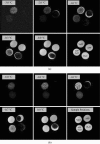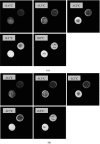Effects of a type I antifreeze protein (AFP) on the melting of frozen AFP and AFP+solute aqueous solutions studied by NMR microimaging experiment
- PMID: 23860838
- PMCID: PMC3532670
- DOI: 10.1007/s10867-012-9291-7
Effects of a type I antifreeze protein (AFP) on the melting of frozen AFP and AFP+solute aqueous solutions studied by NMR microimaging experiment
Abstract
The effects of a type I AFP on the bulk melting of frozen AFP solutions and frozen AFP+solute solutions were studied through an NMR microimaging experiment. The solutes studied include sodium chloride and glucose and the amino acids alanine, threonine, arginine, and aspartic acid. We found that the AFP is able to induce the bulk melting of the frozen AFP solutions at temperatures lower than 0 °C and can also keep the ice melted at higher temperatures in the AFP+solute solutions than those in the corresponding solute solutions. The latter shows that the ice phases were in super-heated states in the frozen AFP+solute solutions. We have tried to understand the first experimental phenomenon via the recent theoretical prediction that type I AFP can induce the local melting of ice upon adsorption to ice surfaces. The latter experimental phenomenon was explained with the hypothesis that the adsorption of AFP to ice surfaces introduces a less hydrophilic water-AFP-ice interfacial region, which repels the ionic/hydrophilic solutes. Thus, this interfacial region formed an intermediate chemical potential layer between the water phase and the ice phase, which prevented the transfer of water from the ice phase to the water phase. We have also attempted to understand the significance of the observed melting phenomena to the survival of organisms that express AFPs over cold winters.
Figures






References
-
- Devries AL, Komatsu SK, Feeney RE. Chemical and physical properties of freezing point-depressing glycoproteins from Antarctic fishes. J. Biol. Chem. 1970;245:2901–2908. - PubMed
-
- Komatsu S, DeVries AL, Feeney RE. Studies of the structure of freezing point-depressing glycoproteins from an Antarctic fish. J. Biol. Chem. 1970;245:2909–2913. - PubMed
Publication types
MeSH terms
Substances
Grants and funding
LinkOut - more resources
Full Text Sources

